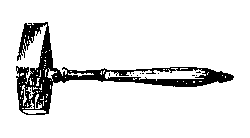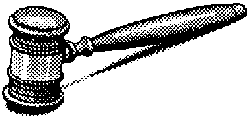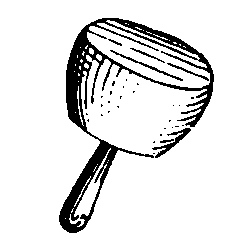Masonic Gavel

The Masonic gavel is an emblem of authority used by the Master of the lodge to show his executive power over the assemblage by punctuating its actions.
In this capacity, order is maintained and a structured outcome to the proceedings is achieved.
The common gavel is also one of the working tools of the Entered Apprentice.
Operative Gavel
In the operative stonemason era, the common gavel was a tool used to hew (break) the rough edges from the stones (ashlars) in order to perfectly fit them into place.
Speculative Gavel
In speculative Freemasonry, the Masonic Gavel is used to symbolically divest the heart and consciousness of all the vices and superfluities (excesses) of life in order to ready ourselves as if we were living stones, open to be shaped into a spiritual being that is pleasing to our Creator.
A True Masonic Gavel
What does a true Masonic gavel look like? The head
of the gavel is rectangular, flat on one end and can be slightly pinched (as you
see, below) or come to a point on the other
end.

Photo Courtesy of MasonicGavels.com
All Rights Reserved
Not An Auctioneer's or Judge's Gavel
The lightweight, rounded-end gavels such as the one, below, commonly used by auctioneers and presiding judges are inappropriate for use in a Masonic lodge.

If your lodge is currently using a gavel which looks like the one, above, please give thoughtful consideration to replacing it with its correct and historic Masonic counterpart.
Not a Setting Maul

A Masonic gavel should not be confused with the Setting Maul, which is one of the working tools of the Fellowcraft.
The setting maul is a heavy wooden hammer with which the operative mason set (knocked) the polished stones into proper alignment.
In the third degree, it is also the final weapon with which the Master was said to have been slain, and, therefore, it is a symbol of violent death.
Traveling Gavel Program
In the United States, some districts or groups of lodges which are geographically close to one another have what is called a "traveling" gavel.
Note: This gavel is not the Master's gavel. This traveling gavel is usually engraved with the district or area's name on it.
The traveling gavel program is designed to promote visitation of other lodges, as a group. Different districts and areas have varying rules on how to obtain the gavel.
Traveling Gavel Program Basic Rules:
- As a courtesy to the Master, he must be
informed of the intention of the visiting lodge members to attempt to obtain the gavel,
previous to the visit.
- Each visiting member must be able to show his dues
card to the Master.
- A minimum of 4 visiting members from the
visiting lodge
must be present in order to obtain the gavel.
- Should 4 or more members from 2 different visiting lodges attend another lodge's meeting, (and be in possession of their dues cards), the lodge with the highest number of visiting members "wins" the gavel.
If these requirements are met, the lodge in possession of the traveling gavel "loses" it to the visiting lodge members, who take it back to their lodge...fully expecting a visit by another lodge, who, again, if they meet the requirements, will then take the traveling gavel back with them to their own lodge.
The traveling gavel program promotes fellowship and social interaction between lodges, each of whom compete to see how long their lodge can be in possession of the traveling gavel.
Hand Made Solid Hardwood Masonic Gavels
Masonic Gifts
A Masonic gavel may be purchased from numerous vendors who sell wooden and Masonic gavels. Some lodges purchase a gavel as a Masonic gift to an outgoing Master, for a Past Master, or as a
personal keepsake for use during your year as Master.
Gavels may be made of a variety of hardwoods,
such as cherry,
mahogany, walnut, hickory, maple, oak, ash, acacia or teak. Some are heirloom
gavels that
can be handed down to your sons and your sons' sons...used within the lodge,
given as Masonic gifts or
used as traveling gavels.
As Masonic gifts, they are also an excellent token of appreciation for a Grand Master, outgoing DDGM, (District Deputy Grand Master), DDGL (District Deputy Grand Lecturer) or other visiting dignitaries.
In addition, some wives purchase a custom gavel for their husbands during his year as Master of the lodge as a Masonic memento to commemorate his ascension into the East. After their year as Master is over, some also choose to frame it under glass and hang it in a prominent place in their home or office.
Related Pages:
Back to Freemason Symbols
5 Fast Methods To Find the Information You Want to Learn About
- Search Box - Use the Search Box at the top of your page.
- Site Map - Use my Site Map page to find the topics you are most interested in.
- Carousel - Use the carousel of pages at the top of your screen.
- Menu Icon - On MOBILE, click the MENU button at the top of each page.
- Masonic Books - Browse through a selection of Masonic books.






